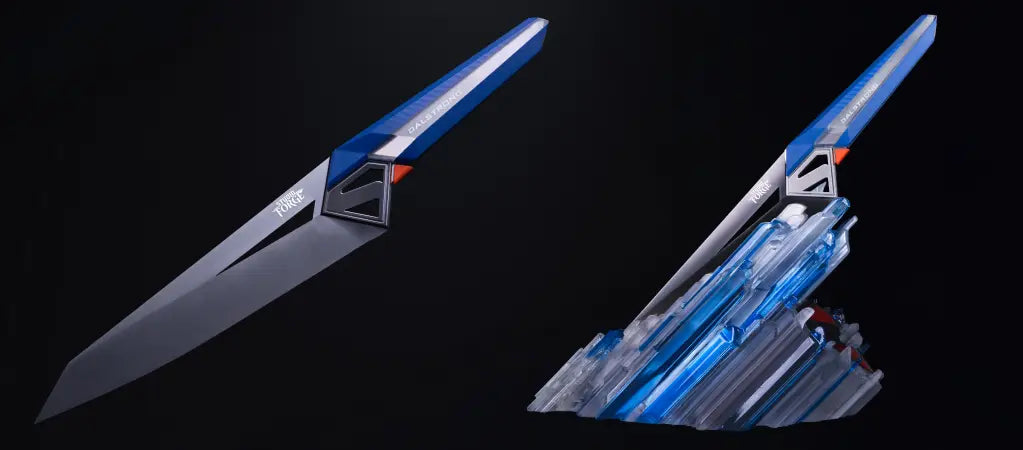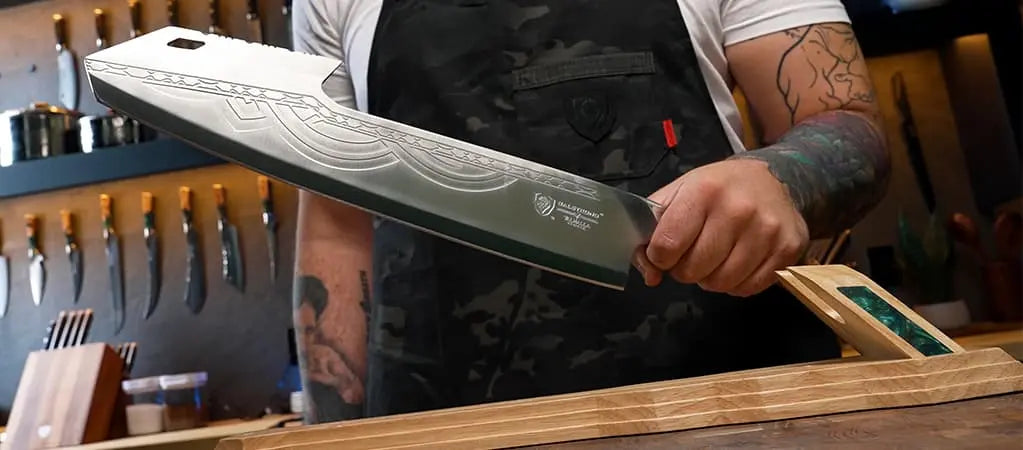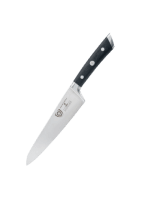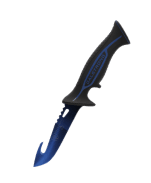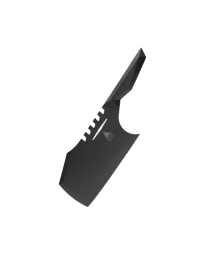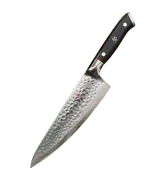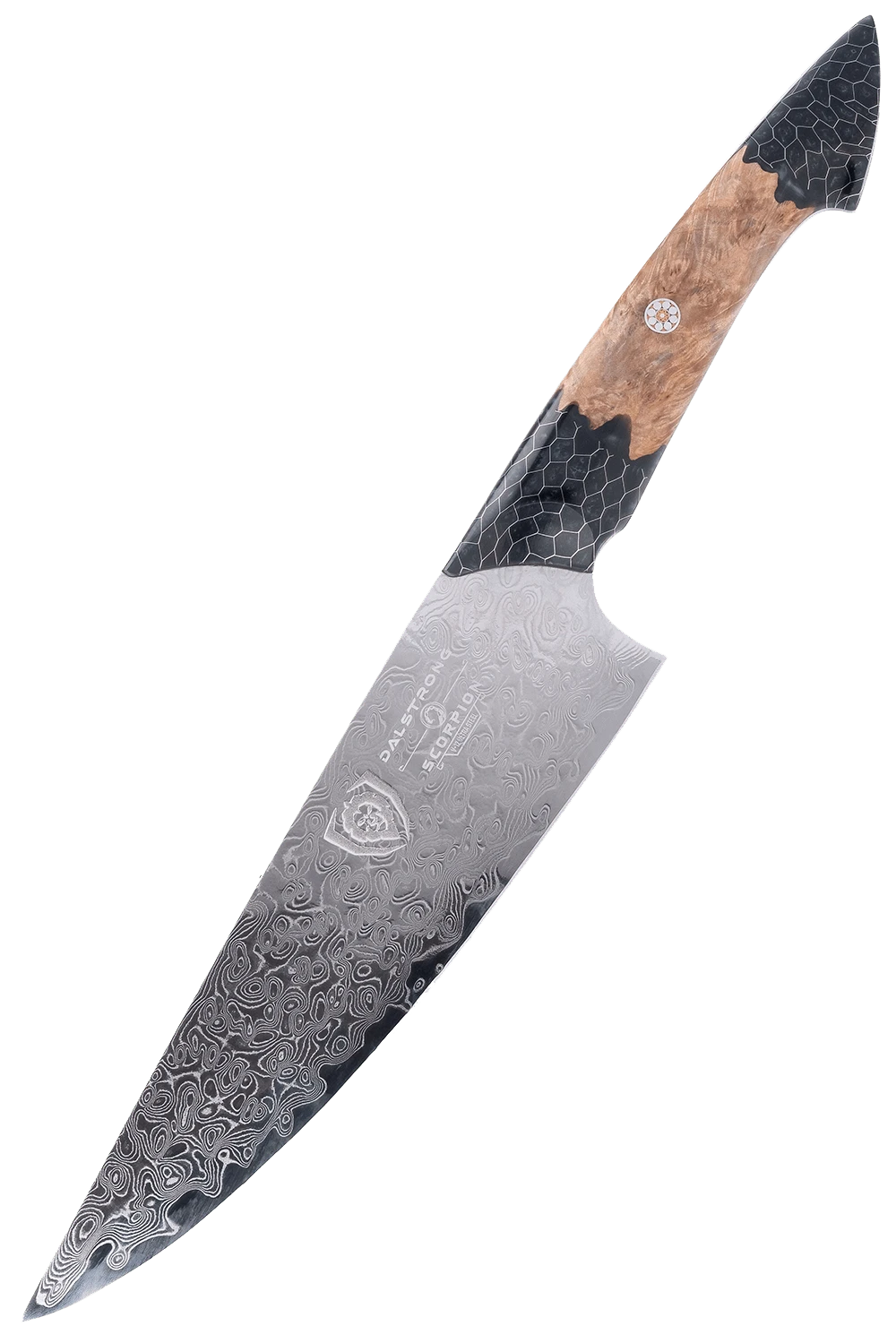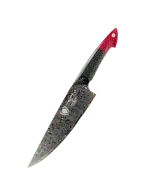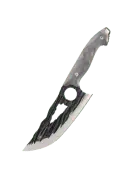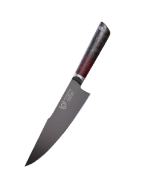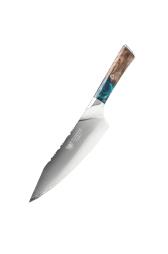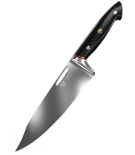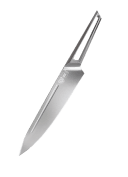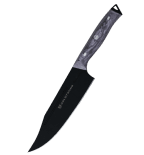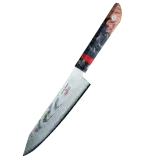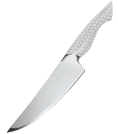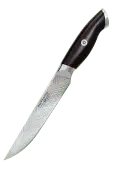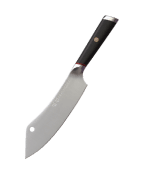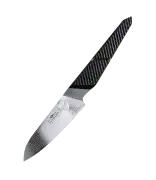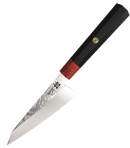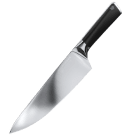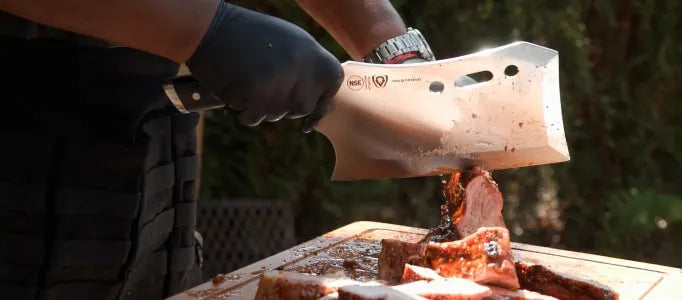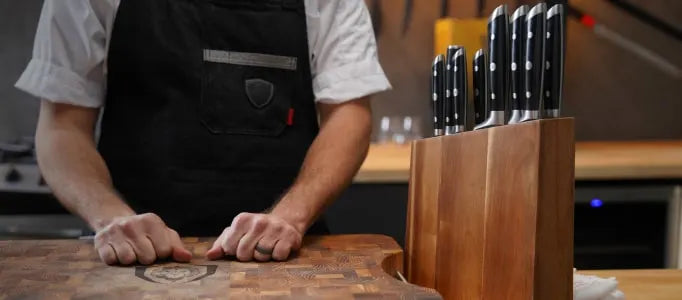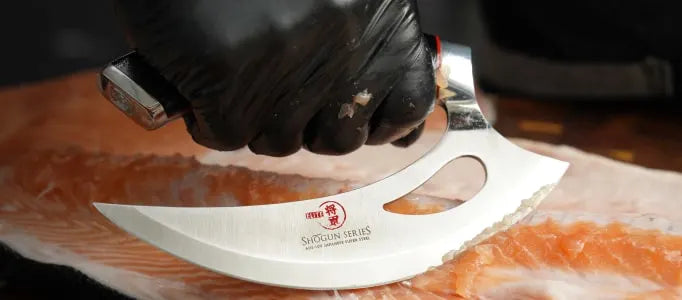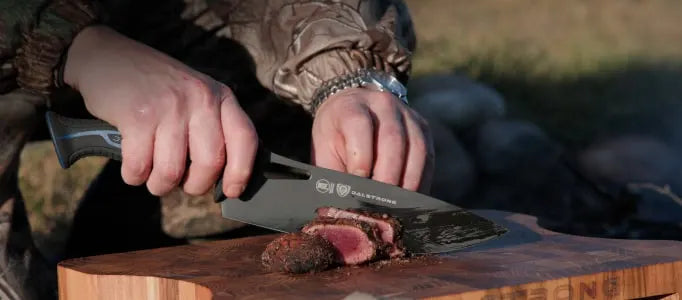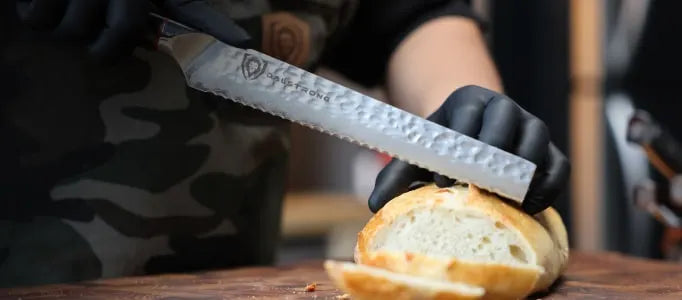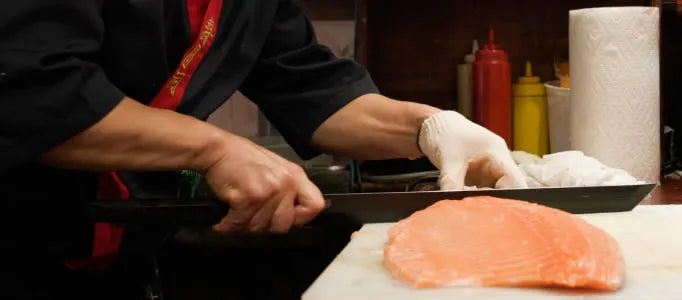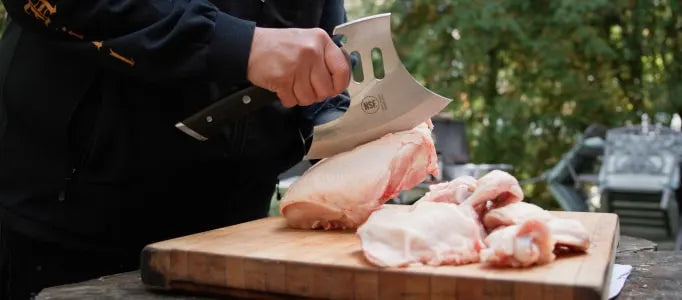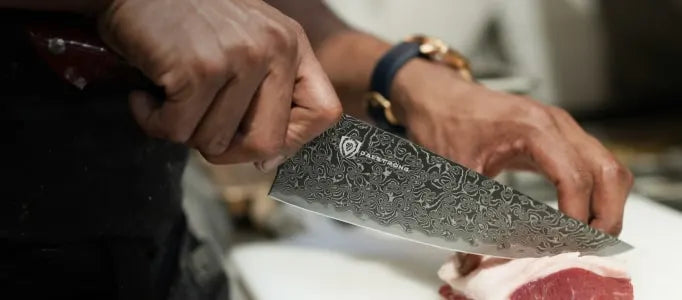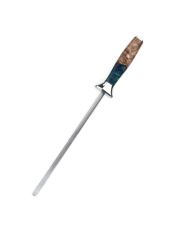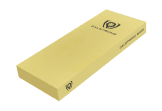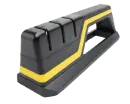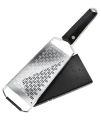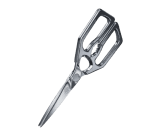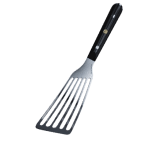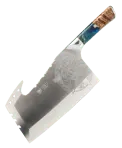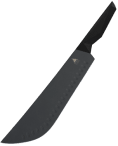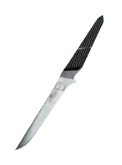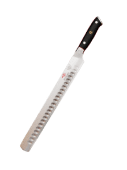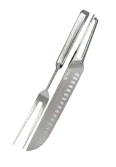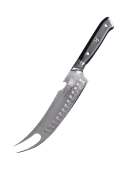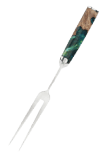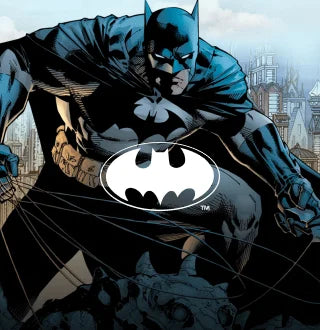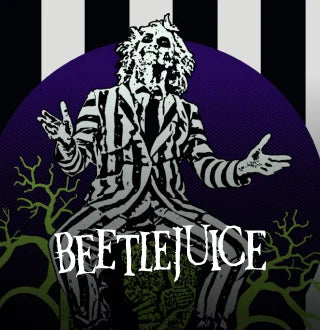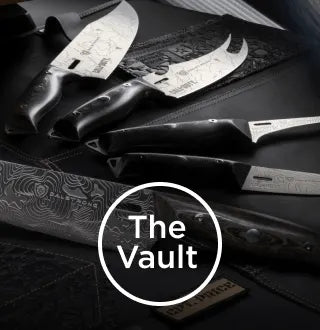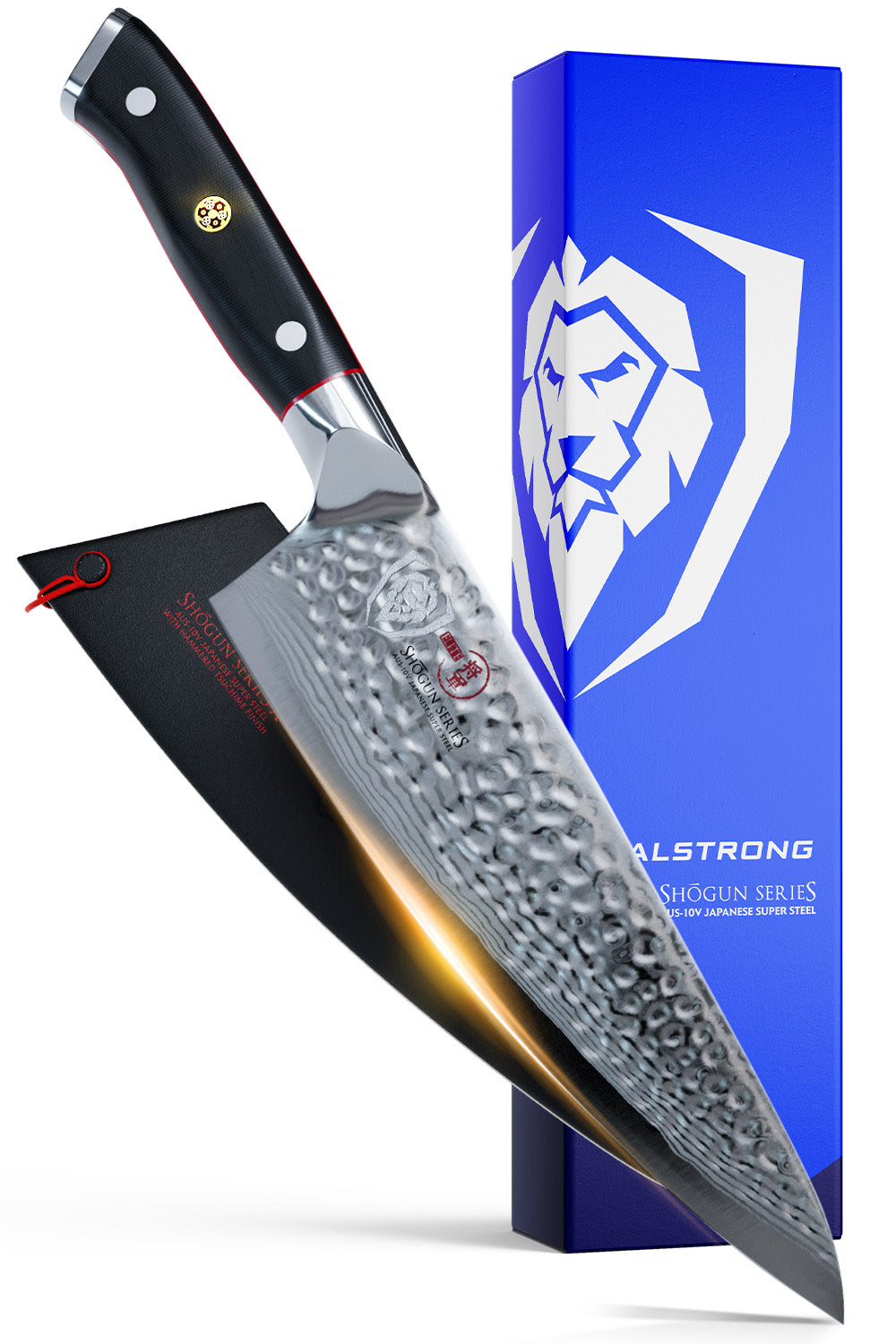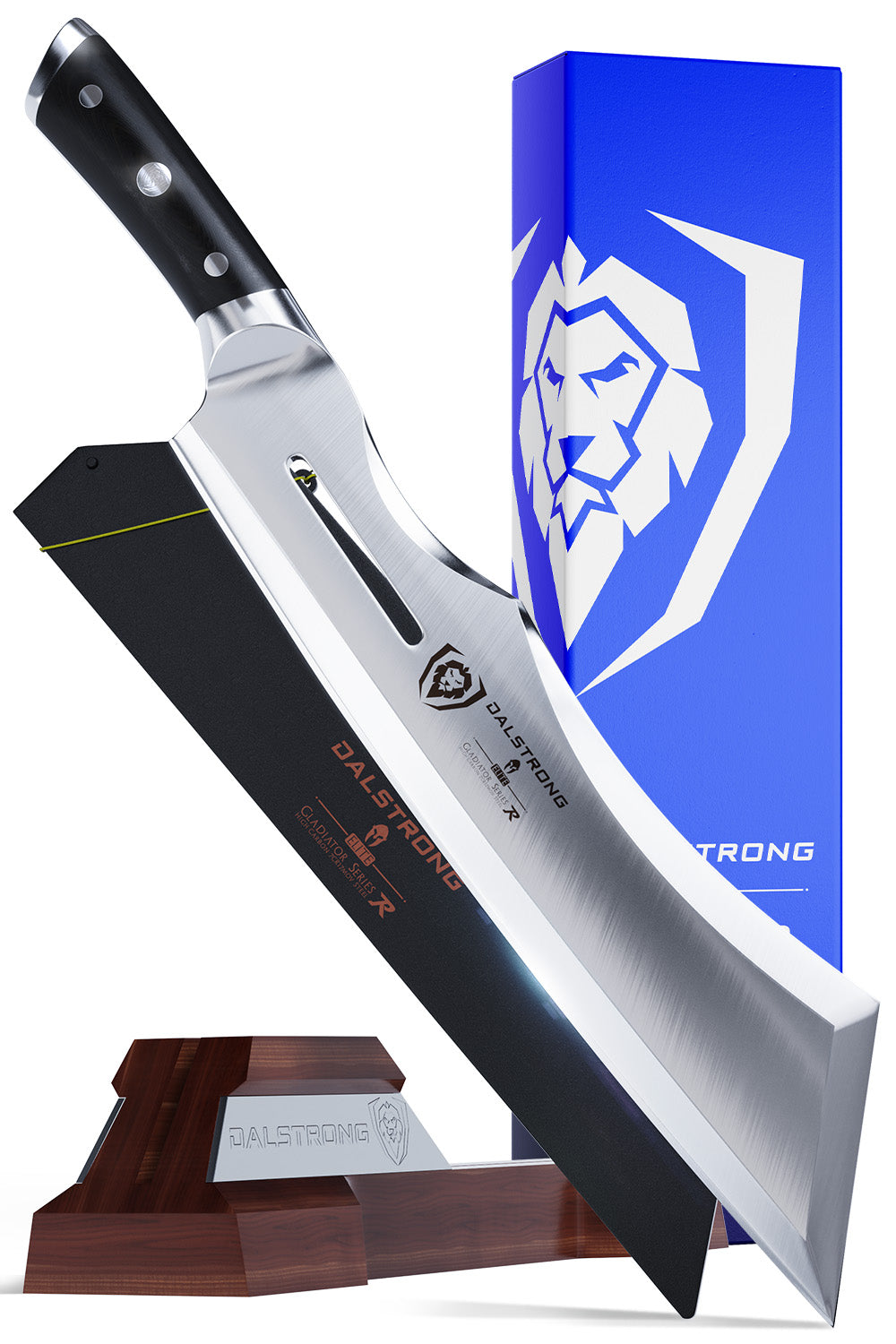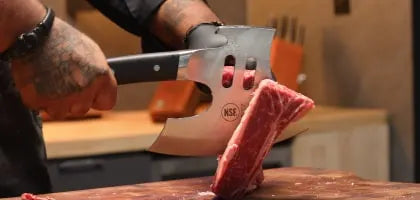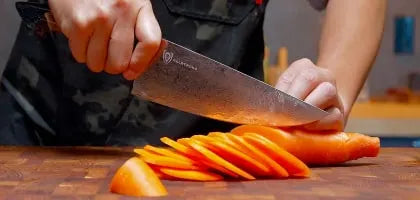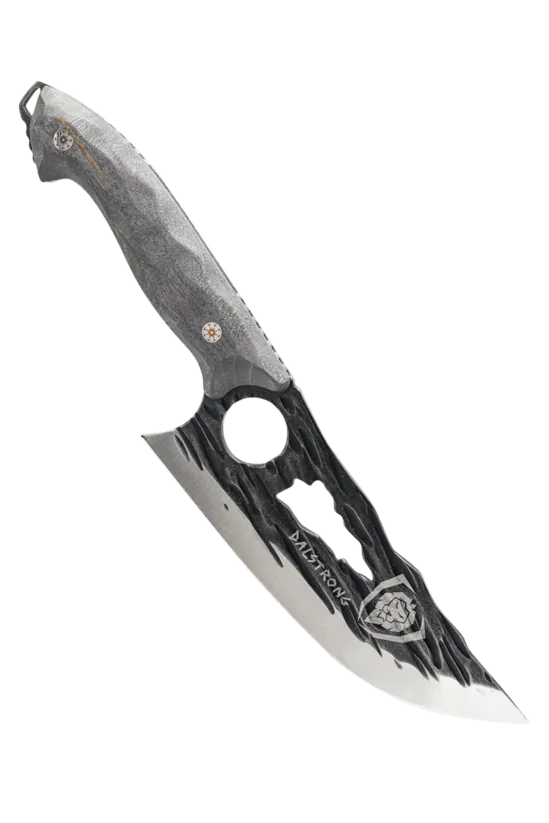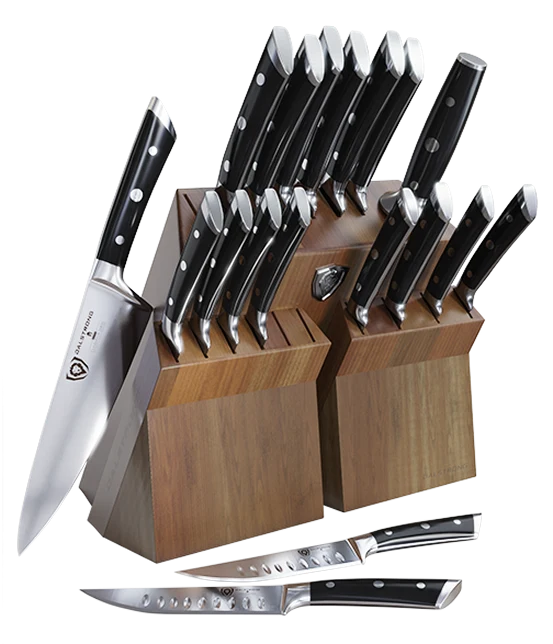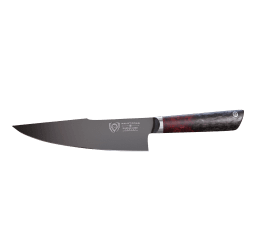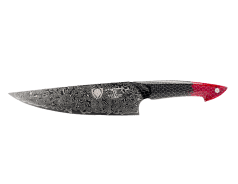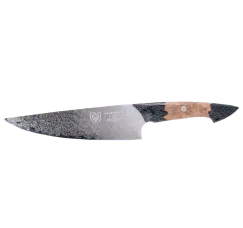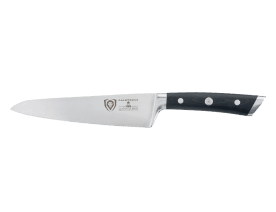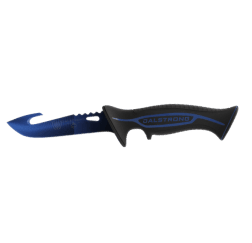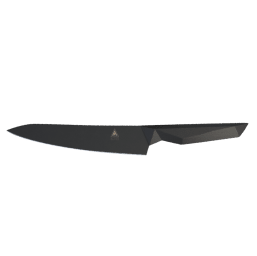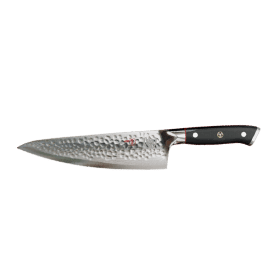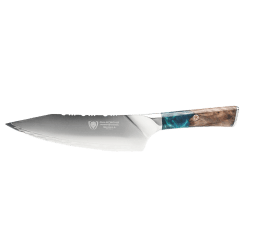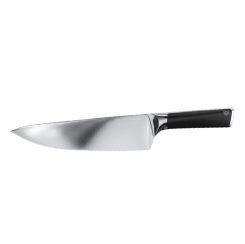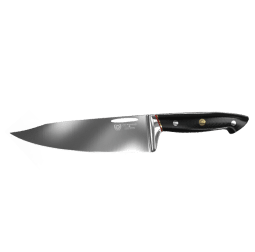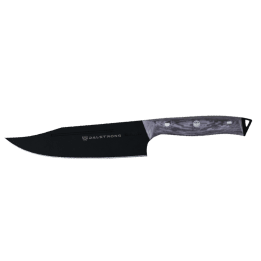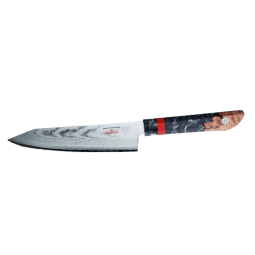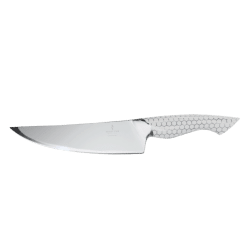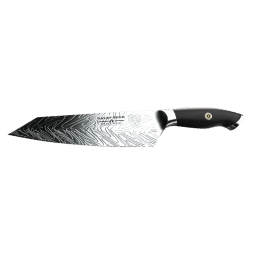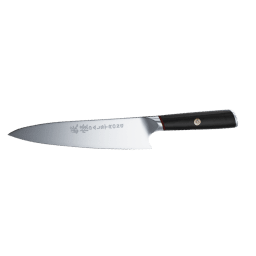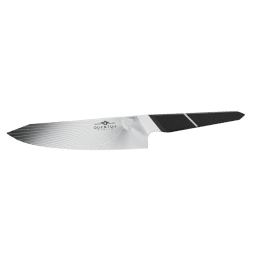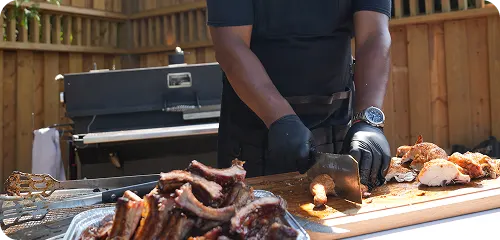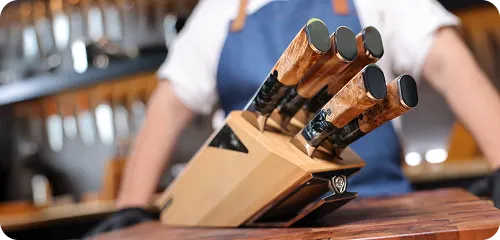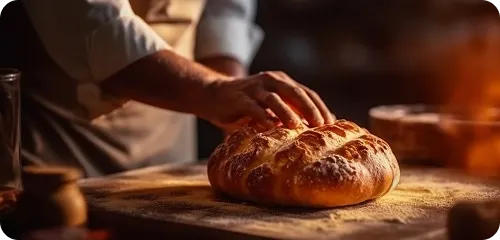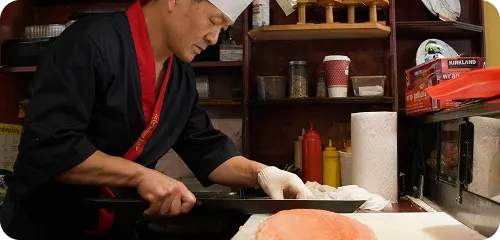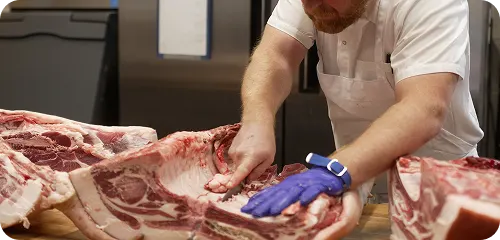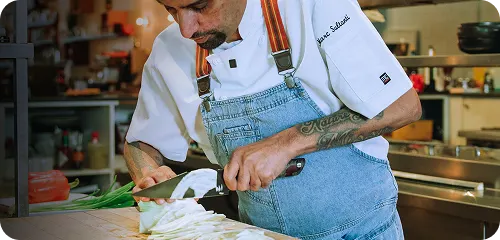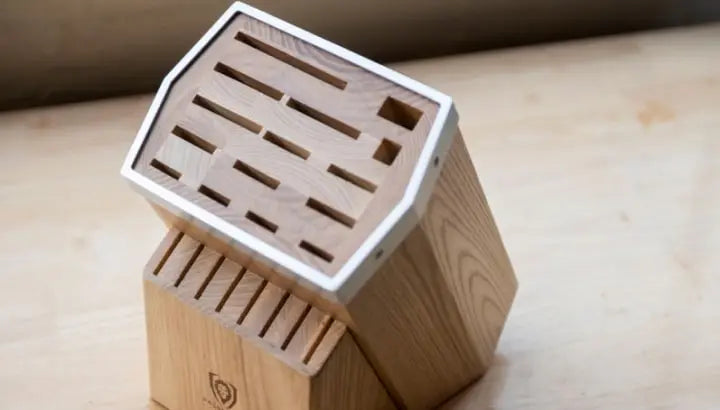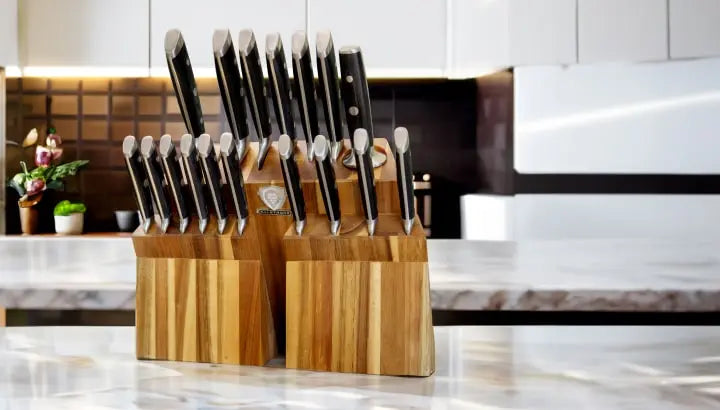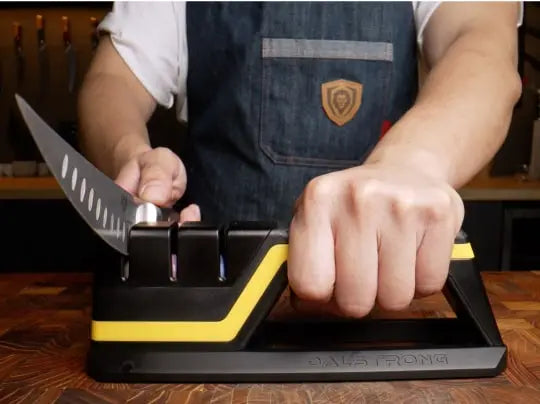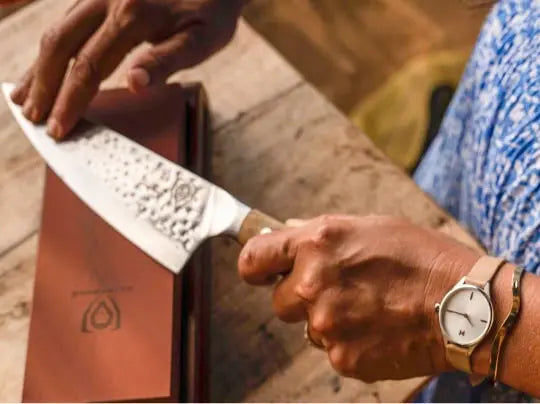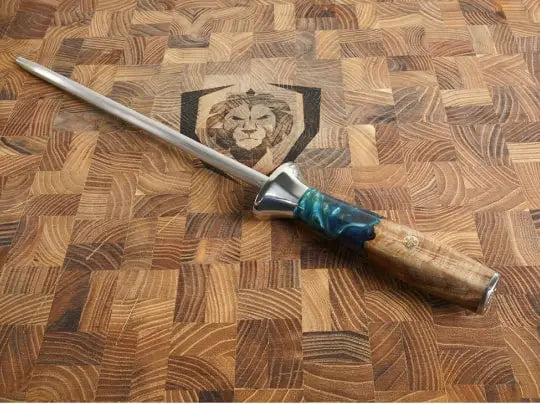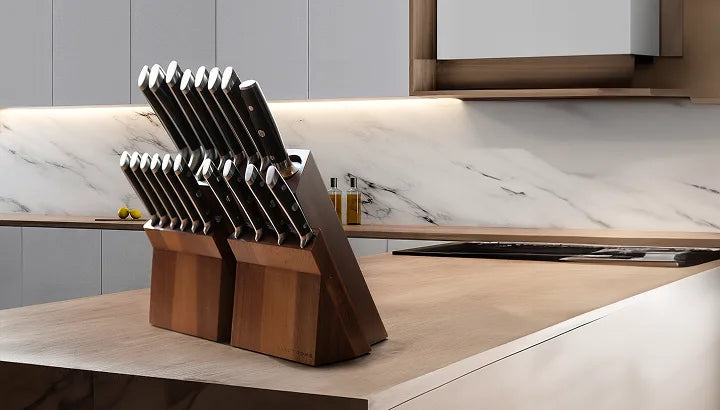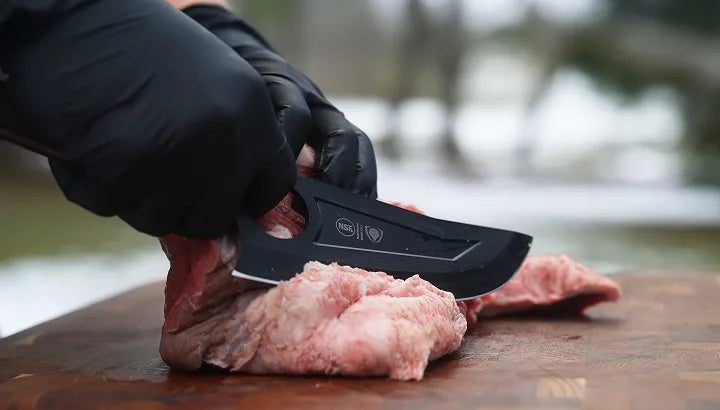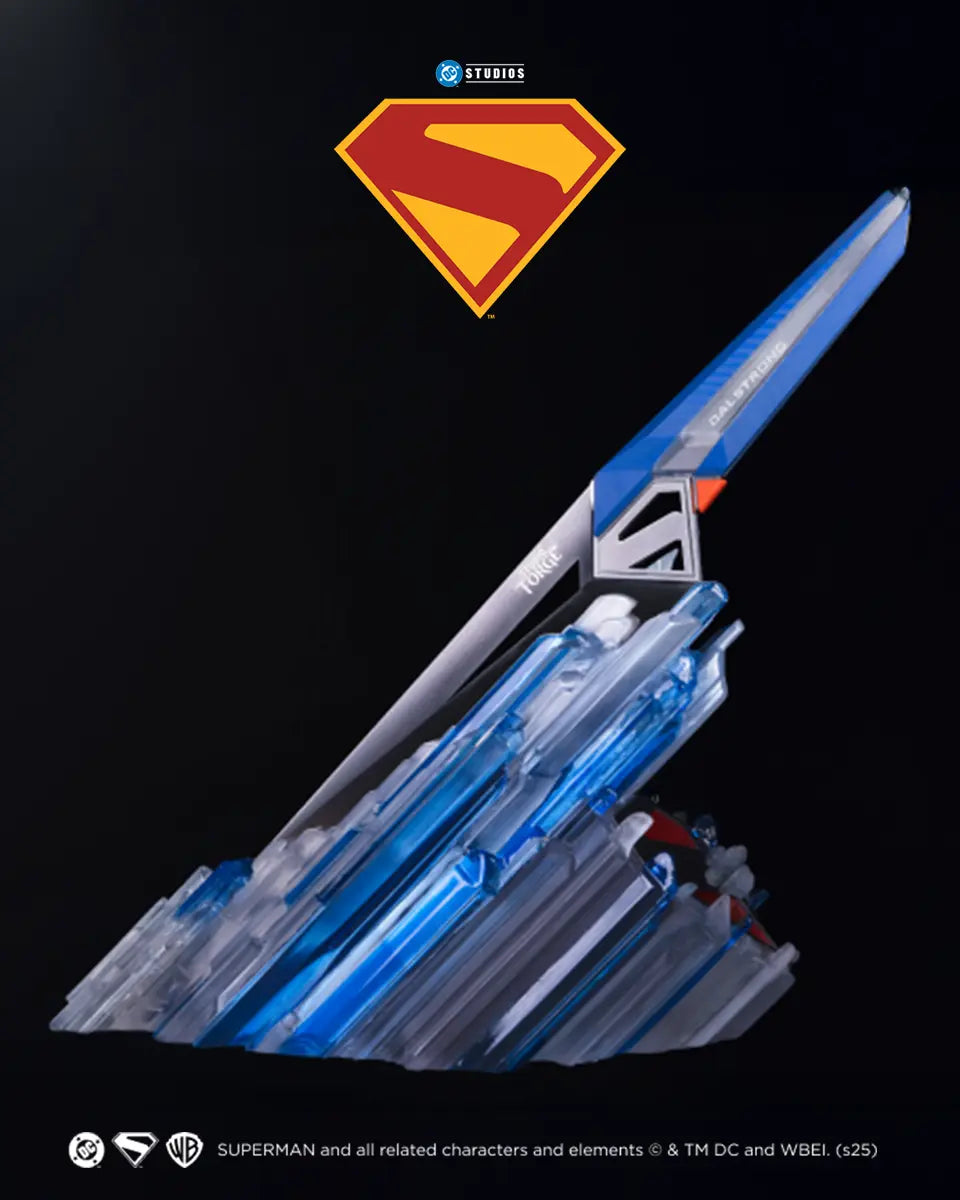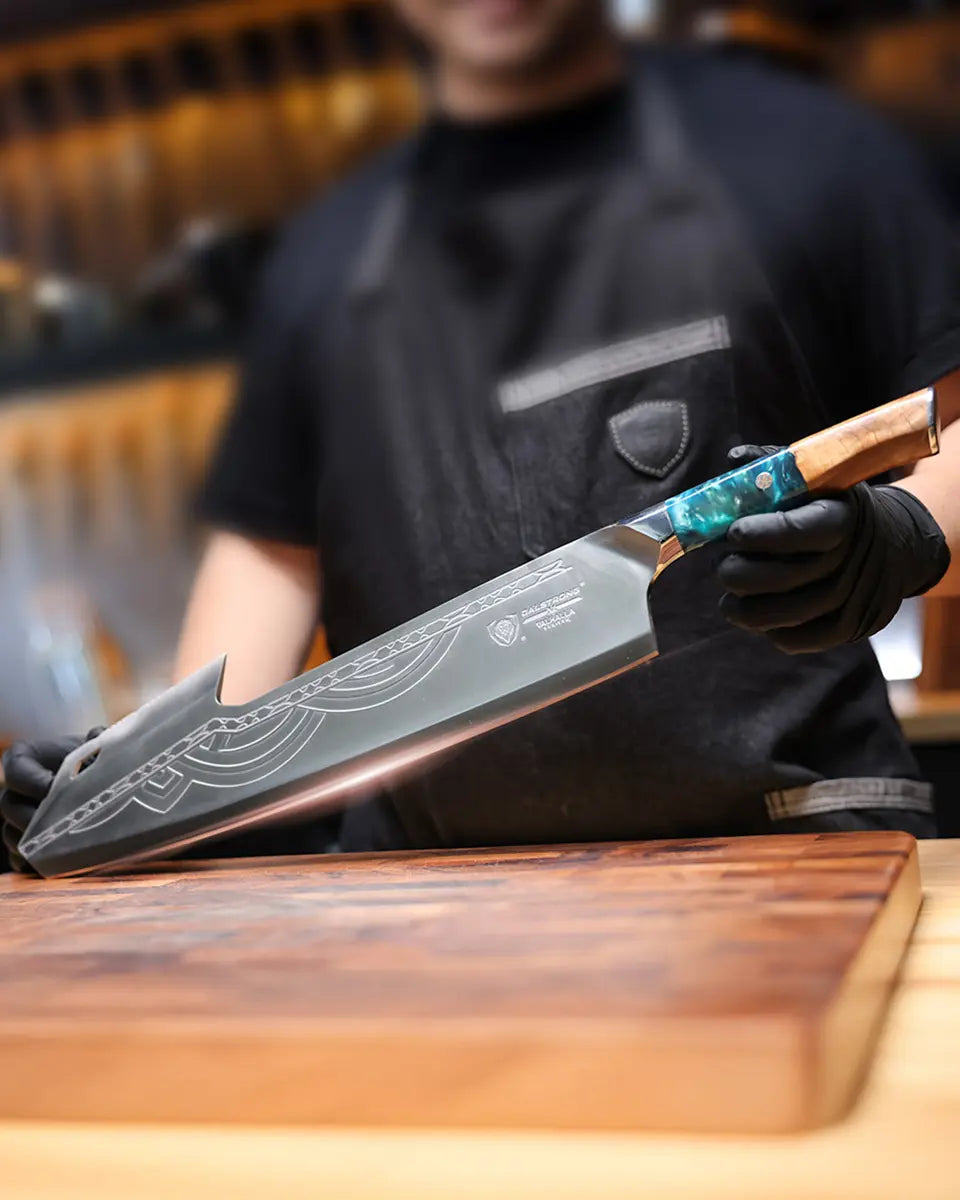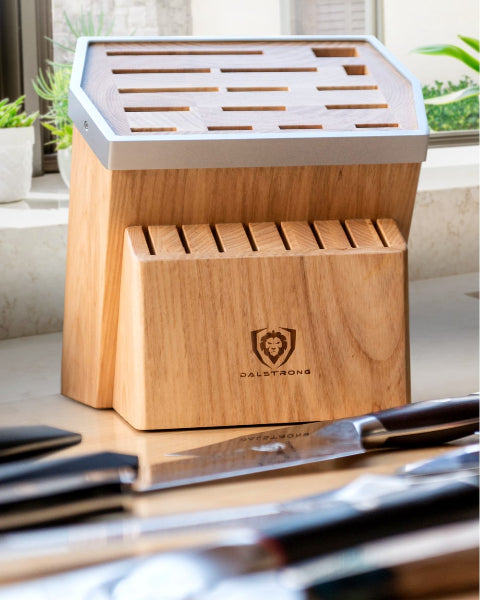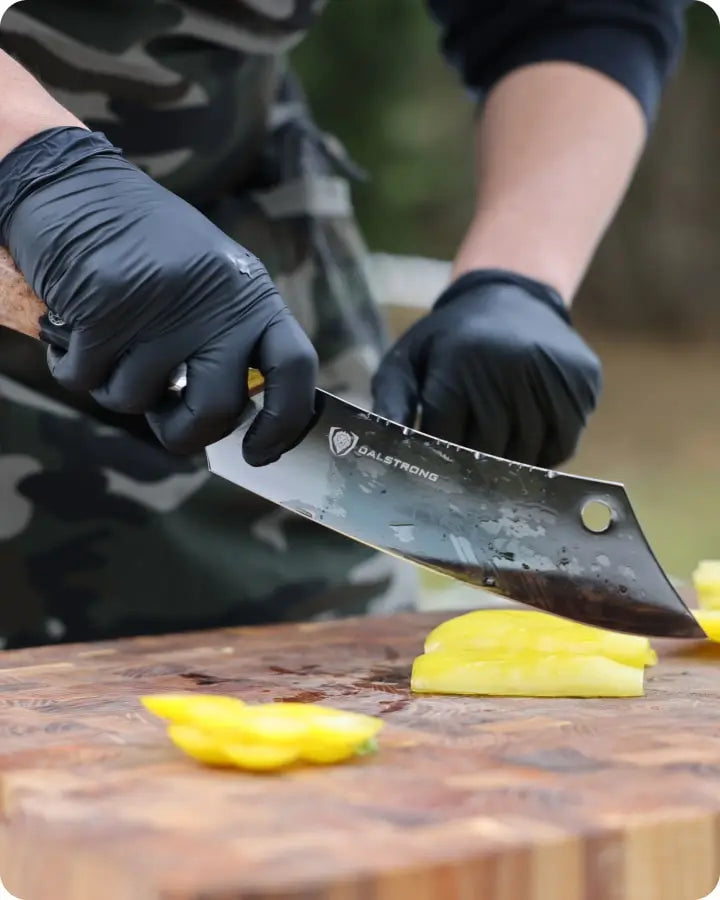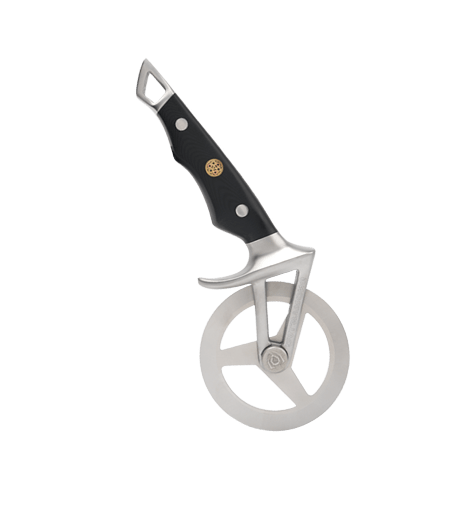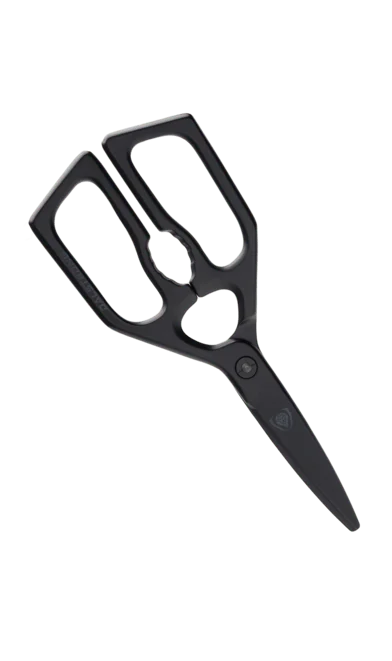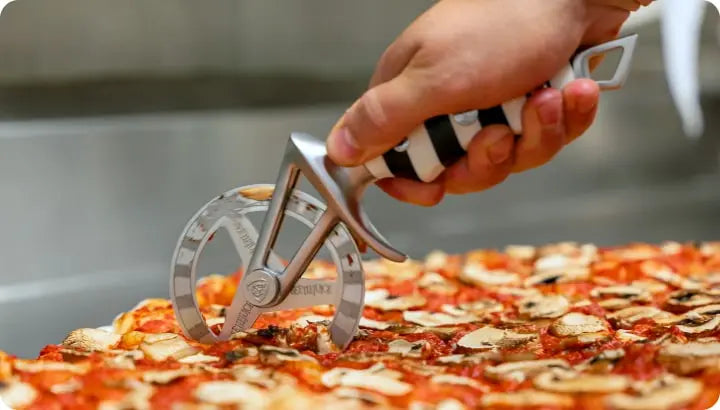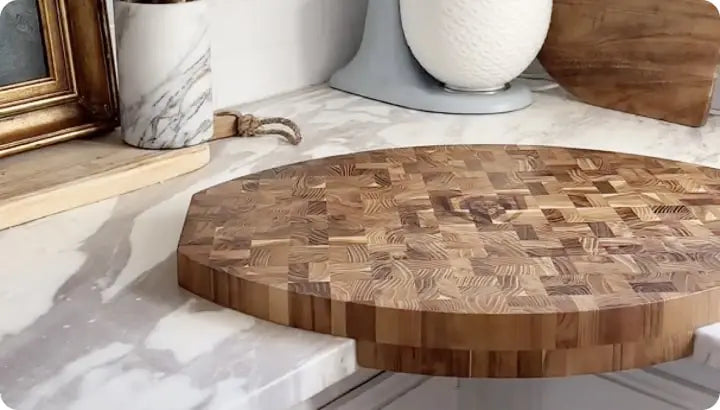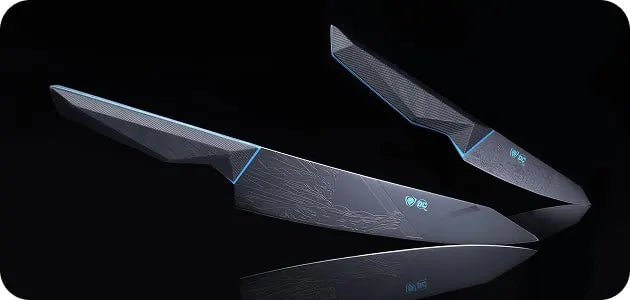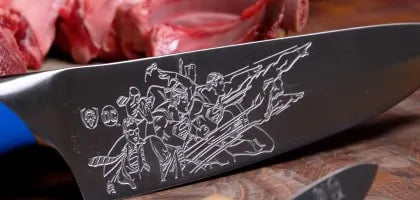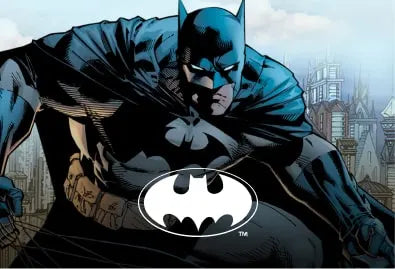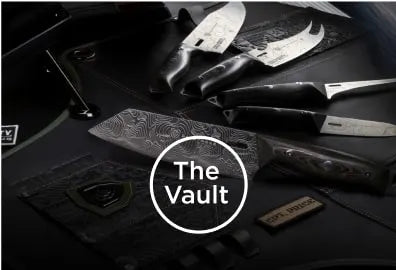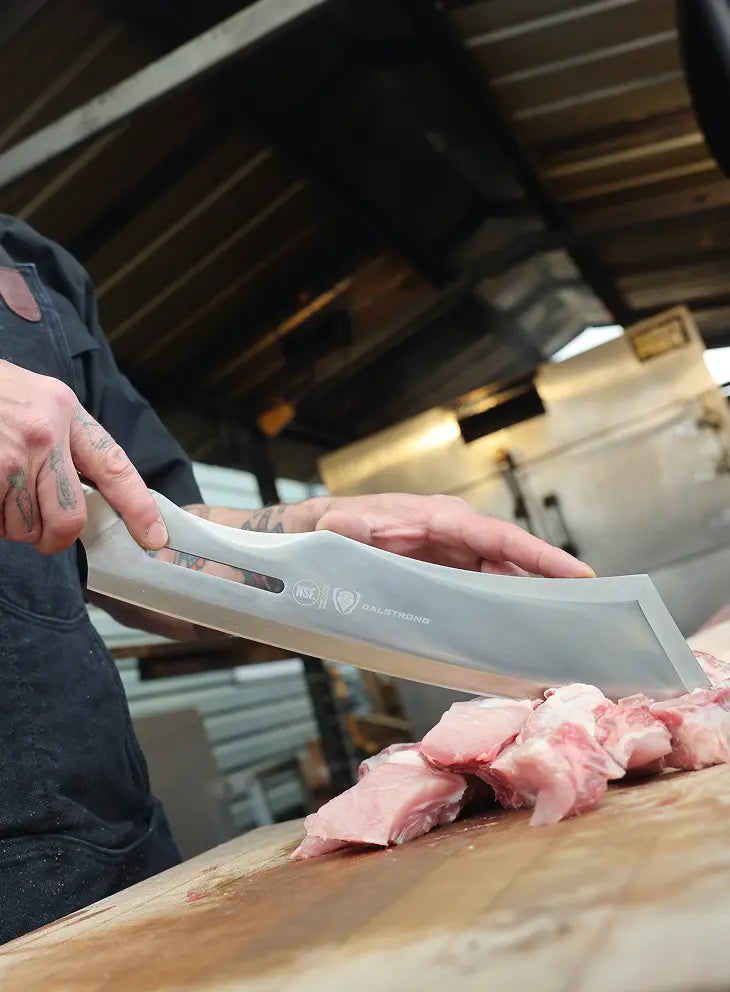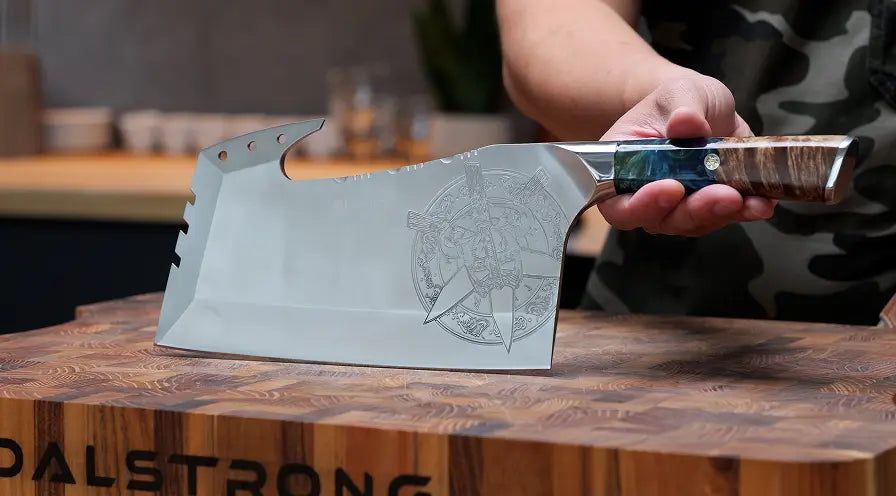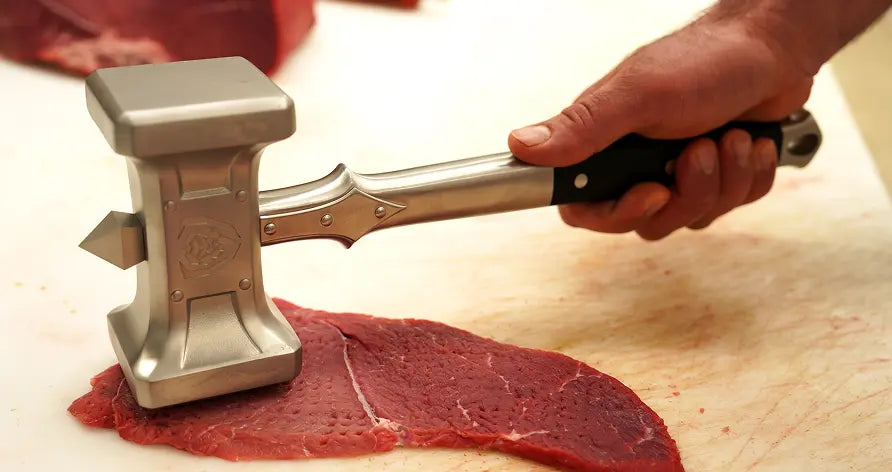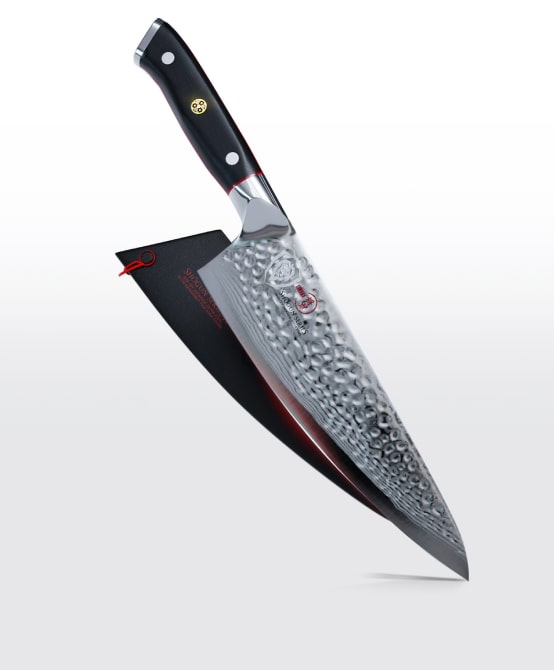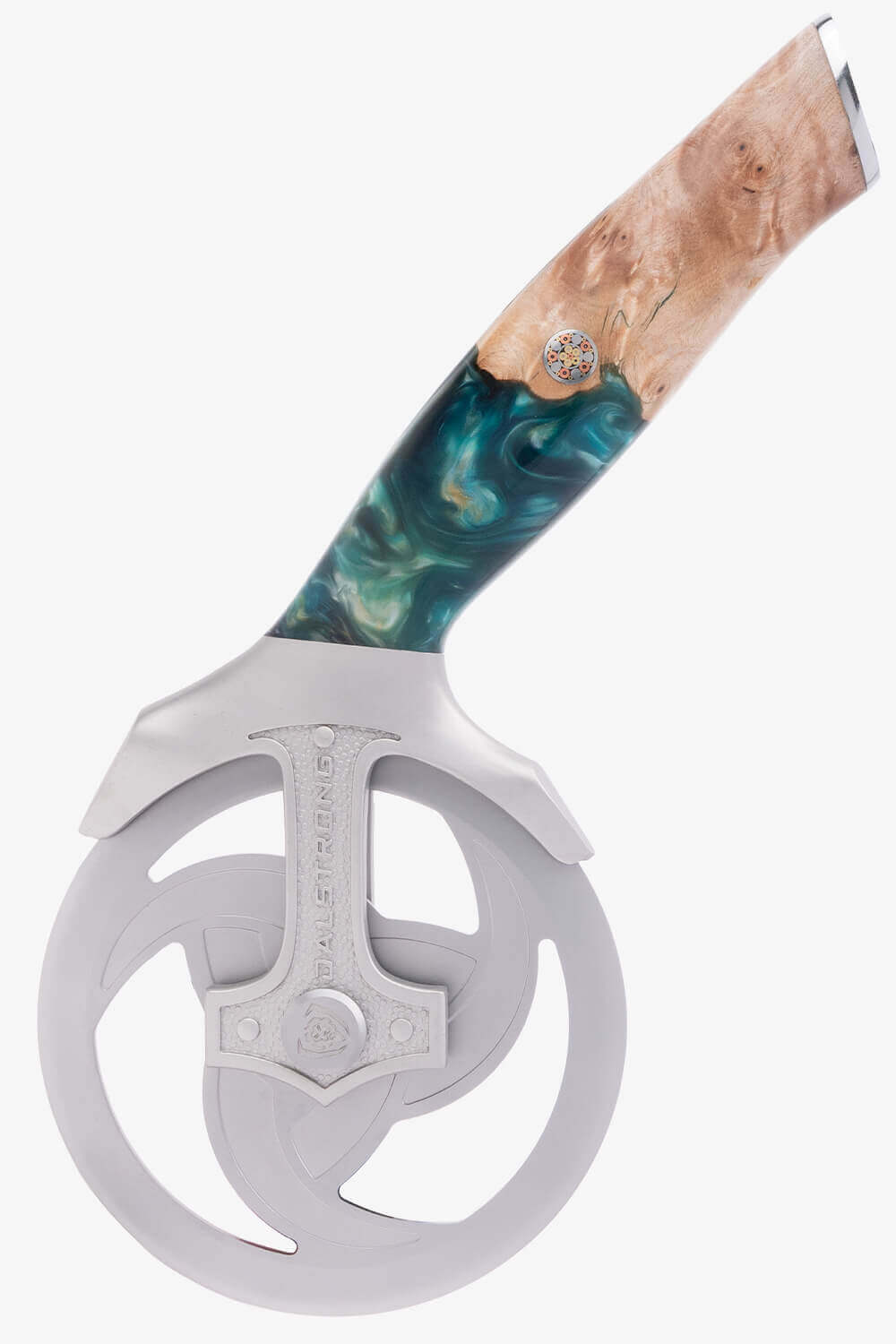
Shadow Black Series Titan Slicer 17"
The best hardness rating for kitchen knives depends on your needs: HRC 55-58 is great for durability and easy sharpening, while HRC 60+ offers awesome sharpness and edge retention for precision tasks.
1. Why Knife Hardness Matters In Your Kitchen
If you've started exploring the world of high-end kitchen knives, you've probably heard about "knife hardness." It's the kind of lingo you hear and you nod, thinking "oh yeah, that just means how tough the knife is, makes sense." But hang on a second. Is there more to it? Is it better for a knife to be harder or less hard? Can a knife be too hard? What's the right number?
Knife hardness isn’t just about bragging rights at the dinner table. It determines how your knife performs, how long it stays sharp, and how easily it sharpens when it eventually dulls. In technical terms, knife hardness is measured using the Rockwell Hardness Scale, which evaluates how resistant a material is to indentation.
How tough is this piece of steel?
Think of knife hardness as the personality of your blade. A chef’s knife with the right hardness can be your trusted kitchen companion, gliding through vegetables, proteins, and even the occasional stubborn squash. On the other hand, a blade that’s too soft might feel like it’s going through an identity crisis, bending and dulling with heavy use.
Why does this matter for your kitchen escapades? Because the harder the steel, the longer your knife’s sharp edge will last -- but it’ll also be more prone to chipping. Softer steel is easier to sharpen but requires more frequent maintenance. In the world of knife blades, balance is everything.
How do hardness scales help?
Hardness scales, like the Rockwell scales, help us quantify these traits. For instance, folding knives and pocket knives might lean towards a softer steel for flexibility, while precision tools like Japanese kitchen knives demand a harder steel to hold a razor-sharp edge. Understanding these differences can help you choose the right tool from a knife set or even justify splurging on that stunning piece from your favorite knife collections.
Take, for example, specialty blades like the deba fish knife, designed for precise cuts in seafood. These knives need just the right hardness to balance edge retention and durability. And let’s not forget knife storage -- a harder blade improperly stored in a knife block can chip if it’s knocked around, while a softer steel blade might just get a little scuffed. Ball bearings play a role in the Rockwell test, measuring the steel’s resistance to indentation -- a clever way to determine where it sits on the scale HRC.
Knife hardness and usability
Knife hardness also affects how the blade feels in your hand. Imagine wielding a chef’s knife that’s too soft; it’s like cutting with a spoon. Too hard, and you’re one slip away from a chipped blade or worse, a nicked countertop. That’s why choosing the right hardness is as crucial as keeping your frying pans seasoned or your cutting boards clean.
When considering knife blocks or knife storage options, remember: softer steel is more forgiving, but harder steel requires a little extra TLC. And if you’re into custom knives or exploring niche tools like those crafted by DKK KR, knowing your hardness scales can elevate your knife knowledge to pro levels.
So, whether you’re debating between folding knives or pondering the blade hardness of your latest addition to your kitchen knife blade arsenal, it all comes down to understanding the balance between durability, edge retention, and ease of maintenance.
2. A Deep Dive Into Knife Hardness Ratings
The Scorpion Series / Venom Edition Slicer Knife 11"
The Rockwell Hardness Scale (abbreviated as HRC) measures steel hardness based on how deeply an indenter penetrates under a standardized load. The test is performed by applying a specific force to the material and measuring the depth of the resulting indentation -- yes, that little indention is measured to give a precise rating. The harder the steel, the higher the HRC rating.
This isn’t just a random number; the Rockwell hardness rating tells you exactly what to expect from your knife’s performance. A knife maker can adjust the steel’s hardness during production to cater to different knife types, like pocket knives, bread knives, or even those ultra-sharp kitchen knife blades you see in Japanese knives. It all comes down to understanding the steel types and what each blade is designed to do.
Why do ratings matter?
Understanding Rockwell hardness ratings is crucial for anyone serious about knife knowledge. The ratings mean a lot more than just durability. They determine the hardness of steel, which affects whether a blade can hold a sharp edge or if it’s prone to chipping. For example, carbon steels tend to have higher hardness values, making them great for precision cutting edges, but they may require more careful handling.
A lower HRC rating doesn’t mean a knife is subpar. Softer steel blades, like those in some bread knives, are easier to sharpen and can withstand rougher use. On the other hand, harder steel -- the kind found in premium blade steels like white steel -- offers superior edge retention but can chip if mishandled. This is where the Rockwell hardness test becomes invaluable: it helps you balance these trade-offs depending on the knife types you’re considering.
Insights into the test
The Rockwell test isn’t just a fancy term. It’s a meticulous process where a machine presses a small steel or diamond ball bearing into the knife’s steel under a specific load. The indention is measured, and voilà -- you get the knife’s Rockwell rating. It’s how knife makers determine the hardness of their products and ensure consistency in quality. Think of it as a science experiment for your blade’s toughness.
How blade hardness influences use
Your knife’s hardness affects more than just edge retention; it also influences how you maintain it. Harder steel knives may require specialized knife sharpening techniques and tools, such as honing rods or sharpening stones tailored for high HRC blades. Softer steel knives are more forgiving and easier to touch up at home -- a bonus for home cooks looking for low-maintenance knife sets.
For collectors, knife hardness ratings can even be a talking point. Custom knives with high hardness values are often viewed as works of art, blending functionality with craftsmanship. Whether you’re gifting a corporate executive a luxury knife or adding to your collection of folding knives, understanding these ratings can help you make an informed choice.
Steel types and their role
Different steel types play a significant role in the hardness of kitchen knife blades. For instance, blade steels like carbon steels are known for their durability and sharp edges, while softer alloys may prioritize flexibility. This is why you’ll see terms like "white steel" or "blade hardness" thrown around by enthusiasts -- they’re not just buzzwords; they’re indicators of quality and performance.
So, the next time you’re browsing knife blocks or considering pocket knives, take a moment to think about what the Rockwell test says about the blade. It might just be the key to finding your perfect kitchen companion.
3. The Ideal Hardness Rating For Kitchen Knives
So, what’s the magic number? For most home cooks, an HRC rating of 55-60 strikes the perfect balance between sharpness, durability, and ease of maintenance. Let’s break it down:
Why not softer steel?
Softer steel (below 55 HRC) is great for tasks requiring flexibility, like filleting fish with a deba knife. However, it dulls quickly and requires frequent sharpening. For those relying on tools like honing rods or natural stone sharpeners, softer steel offers a forgiving experience but demands regular upkeep.
Why not harder steel?
Steel rated above 60 HRC offers incredible sharpness and edge retention, making it a favorite among professionals and knife enthusiasts. However, harder steel is prone to chipping, particularly if paired with improper knife accessories or cutting surfaces. While the sharpness may thrill chefs, it can intimidate home cooks who aren't keen on specialized maintenance techniques.
Finding the Goldilocks zone
Knives with an HRC rating between 55-60 are often considered the "Goldilocks" of kitchen knives -- just right. These knives strike an ideal balance, offering enough hardness to maintain a sharp edge without being overly brittle. They’re the go-to choice for knife handles that feel substantial yet manageable, ensuring control and comfort during use.
The beauty of this range is its versatility. From slicing bread with ease to dicing onions without the blade slipping, these knives hold their edge while forgiving minor misuse. Pairing them with the right knife storage solutions -- such as well-padded knife blocks or magnetic strips -- helps keep them in prime condition.
Insights for the quality kitchen
The Rockwell hardness in knives isn’t just a technical specification; it’s a guide to creating a quality kitchen experience. Measuring the hardness of your knife gives insight into its performance capabilities, but it also highlights the need for complementary tools like knife sharpeners, Dutch ovens, or even the right cutting boards to protect the blade.
Understanding hardness values allows you to expand menu possibilities with confidence. Whether you’re carving a roast or tackling delicate vegetables, these knives ensure precision without demanding overly fussy care. When you hide menu stress and focus on effortless prep, you truly elevate your kitchen game.
4. Dalstrong Hardness Rating
As we've established, the hardness rating, measured on the Rockwell Hardness Scale (HRC), is a key factor when choosing quality blades. HRC ratings determine a knife's durability, sharpness, and suitability for specific kitchen tasks.
Dalstrong offers a variety of knives across different HRC ratings, ensuring that there’s a blade for every chef and purpose. Here’s a detailed breakdown of hardness ratings and how they influence knife performance.
HRC 56+: Rugged and reliable
HRC 56+ is the perfect middle ground for knives that prioritize durability and resilience over extreme sharpness. At this hardness level, the blade offers solid edge retention while being tough enough to handle heavy-duty tasks without chipping or cracking. It’s a more forgiving option for home cooks and professionals alike, especially for those who prefer a blade that’s easy to maintain and sharpen.
Ideal for tasks like chopping through dense foods, deboning meats, or general prep work. This hardness level is great for home kitchens or fast-paced environments where durability is key.
PROS:
- Tough and durable: Resistant to chipping or breaking, even under demanding use.
- Easy maintenance: Quick and simple to sharpen to a keen edge.
- Versatile: Excels in heavy-duty and everyday kitchen tasks.
CONS:
- Edge retention: Shorter lifespan between sharpenings compared to harder knives.
- Moderate sharpness: Does not achieve the ultra-sharp edges of higher HRC knives.
Example:
Barbarian Series Chef's Knife 8"
This knife is a standout for anyone who values durability and versatility in the kitchen. With a Rockwell hardness of 56+, this knife is tough as nails while still being easy to sharpen. That hardness gives the blade just the right amount of resilience -- it can take on heavy-duty tasks like chopping through tough vegetables or breaking down proteins without chipping, but it’s also forgiving enough for everyday slicing and dicing.
What really makes this knife special is how the hardness works with its design. The straight edge is perfect for clean push cuts, while the curved tip makes rock chopping a breeze. The titanium blade coating and “Battle Scar” pattern not only look incredible but also reduce friction and protect the blade from corrosion, which is a big bonus if you’re cooking outdoors or in rugged conditions. It's built to handle anything -- whether you’re in your kitchen or cooking over a campfire.
HRC 58: Balanced versatility
HRC 58 is considered a sweet spot for versatility. Knives at this hardness level strike a balance between edge retention and ease of maintenance. They hold an edge well for general-purpose tasks while being forgiving enough to resist chipping or cracking. These blades are durable, slightly flexible, and easy to sharpen, making them ideal for daily use in busy kitchens.
It's great for home cooks and professionals who need reliable, daily-use knives that can handle a variety of tasks, including chopping, slicing, and dicing.
PROS:
- Good edge retention: Requires less frequent sharpening.
- Durable: Resistant to chipping or cracking under heavy use.
- Easy to sharpen: Can be honed to a razor edge with minimal effort.
CONS:
- Moderate sharpness: May not achieve the extreme sharpness of higher HRC ratings.
- Edge longevity: Edge retention is shorter compared to harder blades.
Examples:
Gladiator Series BBQ & Pitmaster Meat Knife 8" with Forked Tip & Bottle Opener
Here's a really solid example of what makes the Gladiator line so great. The blade is made from high-carbon German steel with a Rockwell hardness of 56+, which means it hits that sweet spot where it’s tough enough to handle heavy BBQ tasks -- like slicing brisket or flipping steaks -- but still easy to sharpen when you need to. It’s not so hard that it’ll chip if you’re working fast, but it holds its edge really well, which is perfect when you’re dealing with a long cookout.
What’s really cool about this knife is how it’s designed with actual barbecue fans in mind. The forked tip makes flipping meat on the grill super easy, and those shallow dimples on the blade help keep food from sticking when you’re slicing through ribs or chicken. The bottle opener built into the spine is a genius little touch. It feels like they really thought about everything a Pitmaster -- or, let’s be honest, anyone who loves grilling -- would want in one tool. It’s a great mix of practical and fun.
Phantom Series Kiritsuke Chef's Knife 9.5"
This blade from Dalstrong's Phantom series is forged from Japanese AUS-8 steel with a Rockwell hardness of 58. That means you’re getting a knife that’s tough enough to handle a busy kitchen but not so hard that it’s a nightmare to maintain. The blade’s edge holds up well, and since it’s ice-tempered, it has just the right balance of resilience and sharpness for precise cuts.
What’s awesome about this knife is how the hardness pairs with its unique design. That kiritsuke shape with the straighter edge is perfect for push cuts -- like slicing through fish or chopping vegetables with ease. Plus, the partial tang makes it lightweight, which is great for those long prep sessions where a heavier knife might tire you out. It’s sharp, elegant, and incredibly versatile.
HRC 60-61: Precision and performance
Blades rated HRC 60-61 offer a higher level of edge retention and sharpness compared to HRC 58 knives. This level of hardness allows for a thinner blade geometry, delivering precision cuts with minimal effort. These knives are ideal for cooks who prioritize sharpness but are willing to handle the extra care required.
They're perfect for precision tasks, such as slicing proteins, filleting fish, or finely dicing vegetables. Recommended for chefs who value sharpness and control.
PROS:
- Superior edge retention: Maintains sharpness longer between sharpening sessions.
- Sharper edges: Capable of more precise cuts and thinner slicing.
- Professional-grade: Ideal for skilled chefs.
CONS:
- Less forgiving: More prone to chipping if misused.
- Challenging to sharpen: Requires more skill or specialized tools to maintain.
Examples:
Valhalla Series Chef & Cleaver Hybrid Knife 8"
This is such a cool piece -- it’s one of those knives that feels like it can handle anything you throw at it. The blade is crafted from 9CR018MOV stainless steel, with an impressive Rockwell hardness of 61+. What that means in real terms is you’re getting a knife that’s incredibly sharp and holds its edge for ages. This level of hardness is perfect for slicing and chopping with precision, whether you’re dicing vegetables or tackling a thick cut of meat. Plus, the sandblasted finish gives it this sleek, battle-ready vibe.
What’s really unique about this knife is how the hardness pairs with its hybrid design. It combines the power of a cleaver with the versatility of a chef’s knife, so you’re covered whether you need to smash through bones or finesse some razor-thin slices. The handle is a work of art too -- wood and resin fused together into something that’s not just functional but also gorgeous to look at. It’s one of those knives that makes you feel like a culinary warrior every time you use it.
Delta Wolf Series Slicing & Carving Knife 12"
The high-carbon 9CR18MOV steel on means this blade is razor-sharp and stays that way for a long time, which is exactly what you want in a slicing knife. That hardness also allows it to have an ultra-thin 1.6mm blade, so you can carve those delicate, uniform slices of turkey or roast with ease and precision.
What really makes this knife stand out is the titanium-nitride coating. Not only does it make the blade look sleek and stealthy, but it also adds an extra layer of toughness and makes the blade non-stick and corrosion-resistant. The G10 camouflage handle isn’t just for looks, either -- it’s incredibly durable, resists extreme temperatures, and has this solid, comfortable grip that makes slicing feel almost effortless.
HRC 62+: Razor-sharp precision
At HRC 62+, knives become tools of precision and artistry. These blades deliver exceptional sharpness and edge retention, making them ideal for professional chefs and advanced home cooks. However, their higher hardness also makes them more brittle, requiring careful handling.
They're best suited for chefs seeking the sharpest edges for precision tasks, such as sushi preparation or detailed garnishing.
PROS:
- Exceptional sharpness: Cuts with little to no resistance.
- Long-lasting edge retention: Stays sharp through extended use.
- Refined performance: Perfect for delicate or intricate tasks.
CONS:
- Brittle: More prone to chipping if dropped or used on hard surfaces.
- Specialized care: Requires careful handling and sharpening techniques.
Examples:
Shogun Series Cleaver Knife 7"
This cleaver knife is such a powerhouse in the kitchen and a great example of why Dalstrong's Shogun series is so popular. It’s made with AUS-10V Japanese super steel and has a Rockwell hardness of 62+, which means it’s built to deliver exceptional sharpness and edge retention. That hardness allows the blade to maintain its razor-sharp 8-12° edge for much longer than softer knives, making it perfect for tasks that require precision, like slicing tough vegetables or breaking down meat.
The 66-layer Damascus steel not only looks stunning but also reinforces the blade’s strength while keeping it light and easy to maneuver. Plus, the hammered Tsuchime finish isn’t just decorative -- it helps reduce friction, so food doesn’t stick as you chop.
Spartan Ghost Series Santoku Knife 7"
Here's the kind of knife that makes you feel like you’re wielding a precision instrument every time you use it. It's built for incredible sharpness and edge retention, which is perfect for tackling fine slicing and intricate cuts. The blade also has a diamond-like LionArmor coating that pushes the steel’s surface hardness to a mind-blowing 100+ HRC. That means it’s not just sharp -- it’s tough enough to resist wear and corrosion for years, even with heavy use.
What makes this knife stand out even more is the ultra-thin 1.4mm spine and convex grind. The blade geometry lets you slice through ingredients with almost no resistance -- it’s like the food just falls apart under the blade. And the handle looks awesome; that blood-red resin mixed with ghost-black stabilized wood isn’t just gorgeous; it’s also super lightweight and comfortable, giving you the control you need for precision work.
Read about how to care for your kitchen knives, here.
5. Frequently Asked Questions
Is 55 Rockwell Hardness good for a knife?
A knife with 55 HRC is easy to sharpen and holds up well for general kitchen tasks. It’s ideal for home cooks who prefer low-maintenance knives.
Is 60 HRC good for a knife?
At 60 HRC, knives offer excellent sharpness and edge retention but require careful handling to avoid chipping. It’s a great choice for experienced users or those who love Japanese kitchen knives.
What is the best HRC rating for knives?
The best HRC rating depends on your needs. For versatility and ease of maintenance, aim for 55-60 HRC. For razor-sharp precision, go above 60 HRC -- just be prepared to baby your blade.
Is 45 HRC harder than 60 HRC?
On the Rockwell Hardness Scale, a higher number means harder steel. So, 60 HRC is significantly harder (and sharper) than 45 HRC.


